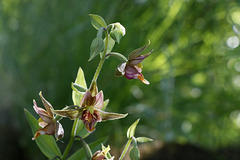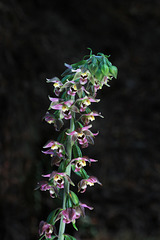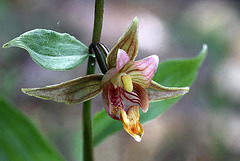RHH's photos with the keyword: epipactis
Epipactis gigantea
| 29 Dec 2023 |
|
|
|
These Stream Orchids were photographed along the Illinois River in Oregon. They are the only native Epipactis species and are also known as the Chatterbox because the lip "chatters" in the lightest breeze, moving up and down. The lower flower has a bee on it which later crawled under the column and flew away with the pollinia.
Stream Orchid
| 29 Aug 2019 |
|
|
|
After traveling down the Oregon coast and spending time in the Redwoods, we spent another few days orchid hunting in northwestern California and southwestern Oregon. These were a few of the orchids we found, this the Stream Orchid or Chatterbox, so named for its moveable lip, along the Little Illinois River in southwestern Oregon.
Stream Orchid
| 21 Jun 2019 |
|
|
|
Known as the Stream Orchid because it always grows near water, or Chatterbox because of its hinged, moveable lip, Epipactis gigantea is rare elsewhere in Washington, but grows by the thousands in the area we visited on our recent trip. It is the only native Epipactis species in North America, though there is one other species that has naturalized across the United States and Canada. The photos were taken on the first day of our trip amid a cloud of mosquitoes and in a very wet and swampy location.
Stream Orchids
| 21 Jun 2019 |
|
|
|
These are the masses of Stream Orchids we photographed in a wet and swampy area in Dry Falls State Park in Washington. Rare elsewhere in the state they grow my the thousands here.
Stream Orchids
| 21 Jun 2019 |
|
|
|
Epipactis gigantea, the Stream Orchid or Chatterbox, is the only species in the genus that is native to North America. Rare in Washington, it grows by the thousands in the area we visited on our recent trip.
Broad-leaved Helleborine
| 13 Oct 2015 |
|
|
|
The Broad-leaved Helleborine is usually counted among our native orchids, since it has naturalized in many different locations, but it is in fact not a native and not even a North American species. It was brought to eastern Canada by settlers in the 19th century who used it to curdle milk, and has since spread across southern Canada and the United States. Interestingly, we've found it mostly long railways or old abandoned tracks.
Epipactis gigantea
| 19 Jul 2015 |
|
|
|
This photograph helps explain where I've been the last few days. I've been orchid hunting with friends on the northern end of the Olympic Peninsula mostly in Olympic National Park. I left early Thursday morning and met a friend from Edmonton and his son and spent the day with him, taking him to different orchid sites on the Olympic Peninsula and searching for new sites. I met him again Friday and we were joined by a friend from eastern Washington and another friend from Minnesota for another day of orchid hunting. Today after bidding all of them farewell, I led a field trip for the Washington Native Orchid Society, visiting again some of the same sites. The summer has been very hot and dry and the orchids were not as frequent as usual, but we ended up seeing eight species in bloom and found a number of others that were either finished or not yet ready to bloom. This orchid, though near the end of its blooming season, was the star of the show. It is the only Epipactis native to North America and is known as the Stream Orchid on account of its love for river and lake sides, often growing with its feet on the very edge of the water. It is also known as the Chatterbox for its moveable lip with "chatters" up and down in the slightest breeze.
Double Flower
| 31 Dec 2013 |
|
|
|
This is another photo of Epipactis gigantea, the Stream Orchid or Chatterbox, but in this case a double flower. There are two lips (the orange-brown parts at the bottom of the flower) , two columns (the yellow hooked pieces inside the flower) and four petals (the flat pink parts at the top of the flower). This is a mutation but probably not permanent since there was only this one of several flowers on the plant that looked like this, but interesting nevertheless. It was photographed in Olympic National Park.
Stream Orchids
| 30 Dec 2013 |
|
|
|
This photo was taken by my wife and shows the Stream Orchid or Chatterbox, Epipactis gigantea, in situ. A close-up shot of the flowers is included below. This is a typical setting for the species, near a river or lake, sometimes so close that it is almost in the water. The photo was taken in Olympic National Park and I thought she did a fine job on this and liked the inclusion of the blackbird in the shot.
Chatterbox
| 21 Dec 2013 |
|
|
|
This was the second native orchid we photographed near Crescent Lake on the first day of our trip to the Olympics. This is the Stream Orchid, Epipactis gigantea. It is the only Epipactis native to North America though we have another European species in the area that has colonized itself. The Stream Orchid is also known as the Chatterbox because of its moveable lip which bobbles up and down in the slightest breeze.
Epipactis gigantea
| 10 Jul 2013 |
|
|
|
Known as the Stream Orchid for its propensity for wetter areas and also as the Chatterbox for its moveable lip which "chatters" up and down in the slightest breeze, Epipactis gigantea is one of our more colorful native orchids. It is fairly rare in Washington but can be quite common in some areas. This was photographed in southern Oregon and a close look will show a small bee which spent a great deal of time working its way under the anther cap of the upper flower and which finally carried away the pollinia.
nativeorchidsofthepacificnorthwest.blogspot.com/2012/07/stream-orchids-and-western-ladies.html
Broad-leaved Helleborine (Epipactis helleborine)
| 17 Oct 2010 |
|
This orchid is not really a native, but a European import that has naturalized itself all across the country. It was first reported in Canada in the late 1800'sand since then has spread quickly. We found it growing along a railway line, an indication, perhaps, of how it has spread. Further pictures and a description of this lovely "weed" can be found at: nativeorchidsofthepacificnorthwest.blogspot.com/2010/09/b... .
Chatterbox
| 15 Sep 2011 |
|
Epipactis gigantea, one of our northwest native orchids is known as the Chatterbox Orchid because of its moveable lip which "chatters" in the slightest breeze. It is also known as the Stream Orchid because it grows in very wet areas, in this case on the edge of a lake.
The movement and the location made photography in this case especailly difficult. We had to deal with the movement because there was a slight breeze the morning this photo was taken, and we had to kneel in the water to get the right angle on the flowers.
These were photographed at Crescent Lake in Olympic National Park in a rather high use area with a beach. Sadly, one of the park staff had come through the area with a weedeater and had mowed most of them down so that only a few stems were untouched.
nativeorchidsofthepacificnorthwest.blogspot.com/2011/09/e...
ronaldhanko-orchidhunter.blogspot.com/2011/09/olympic-nat...
Epipactis helleborine
| 18 Feb 2013 |
|
This is one of the native orchids that we go see in Larrabee State Park. The trail to Clayton Beach, a remote area of the park, follows a path through the woods, crosses a railroad track and includes a couple of scrambles down the rocks. This orchid is found above and below the tracks and along them.
Epipactis helleborine, the Broad-leaved Helleborine, is not truly a native, but a European import first found in the US in 1878 that has spread all across the northern part of the country and of southern Canada. It is one of two Epipactis species in the Pacific Northwest, the other a true native.
nativeorchidsofthepacificnorthwest.blogspot.com/2012/10/t...
Epipactis helleborine
| 19 Feb 2013 |
|
Here's another photo of the Broad-leaved Helleborine, the European plant that was, according to the reports I've read, introduced into this country by settlers who considered it a remedy for gout. This photo of a more colorful form than the green and pink flowers I posted earlier (see below)
There is huge variation in these. The plants themselves vary in size from a foot to four feet tall. The flowers vary in color from green to a deep pink or purple and the flowers, which also vary a great deal in number, are sometimes widely spaced as on this stem and sometimes crowded together.
nativeorchidsofthepacificnorthwest.blogspot.com/2010/09/b...
Epipactis helleborine
| 22 Feb 2013 |
|
|
One more picture of this species, this time of a very dark flowered plant, this one also from the Clayton Beach area of Larrabee State Park. The variation in color, flower number, and size of the plants is amazing.
nativeorchidsofthepacificnorthwest.blogspot.com/2010/09/b...
Epipactis helleborine
| 21 Feb 2013 |
|
My photos of this orchid species have drawn considerable comment from those who know it in Europe and who are surprised at how different these plants are from what they know. Here is another photo showing a side view of the flowers. The whole matter has interested me to the point that I hope to do further investigation this summer when they bloom again and will check with the University of Washington Herbarium to see if they can give me any information. For those who have not seen the previous photos, this is the Broad-leaved Helleborine, a non-native, introduced into this country in the late 1800's by European settlers.
nativeorchidsofthepacificnorthwest.blogspot.com/2010/09/b...
Jump to top
RSS feed- RHH's latest photos with "epipactis" - Photos
- ipernity © 2007-2025
- Help & Contact
|
Club news
|
About ipernity
|
History |
ipernity Club & Prices |
Guide of good conduct
Donate | Group guidelines | Privacy policy | Terms of use | Statutes | In memoria -
Facebook
Twitter

















